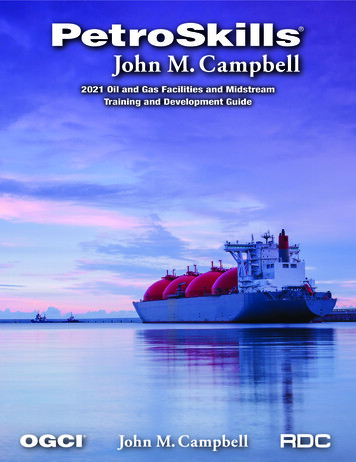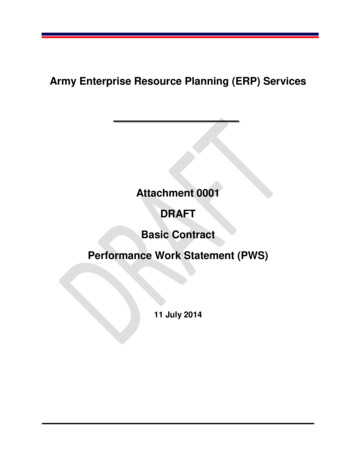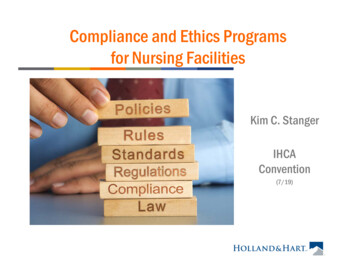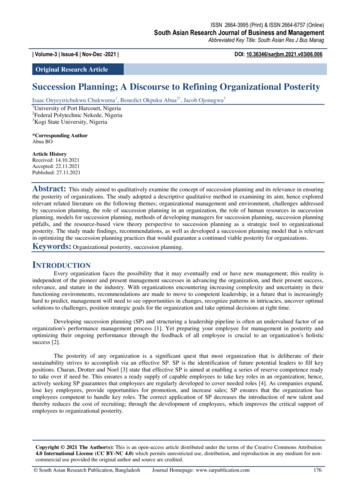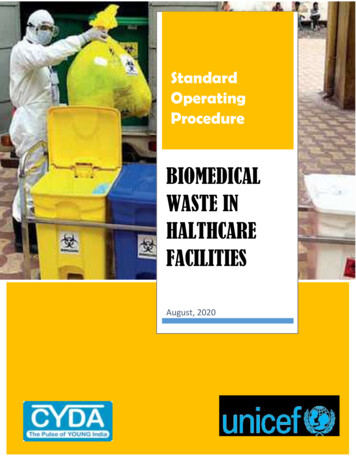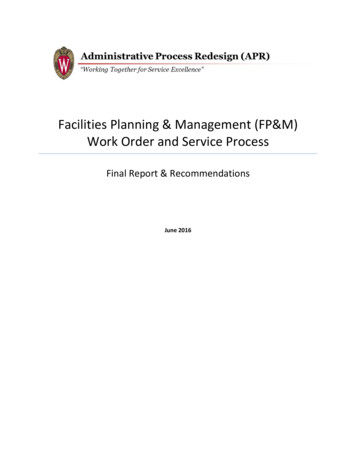
Transcription
Facilities Planning & Management (FP&M)Work Order and Service ProcessFinal Report & RecommendationsJune 2016
Background.3Project Methodology .5Service and After-Hours .6Data . 6Findings and Recommendations . 61.2.3.4.5.Intake and Work Requests .6FP&M Leadership and Management .7Work Order System .8Billing .9Communication .10Future State Process Map . 11PAC - Small Project Delivery . 13Data . 13Findings and Recommendations . 141.2.3.4.Leadership and Organizational Change .14Information Technology (IT) .15Communication .18Policies & Procedures.19Future State Process Map . 22Accomplished to Date . 22Next Steps . 23Appendices . 24FP&M WO Process - Final Report & RecommendationsPage 2 of 30Report Date: June, 2016
BackgroundLeadership within Facilities Planning & Management (FP&M) has received feedback that somecustomers perceive FP&M Physical Plant as not being timely or within cost estimates when addressingservice requests, providing required maintenance, or delivering in-house remodeling projects. As aresult, it was decided that a thorough review of the FP&M Physical Plant Work Order process wasnecessary. As a first step, and to assist in defining the approach to the overall project, a work team withcross-campus representation was formed in Spring 2015 to reach out to campus customers to helpbetter understand the customer experience with the current FP&M Work Order and ProjectAdministration Center (PAC) 1 processes.Three key themes for improvement emerged from these interviews: Communication, Cost/Billing, andTimeframe for completion of work. By contrast, customers reported that the quality of the workmanshipis where FP&M excels. This data validates what FP&M leadership had heard anecdotally and can besummarized as follows:1. The work order process is neither responsive nor user friendly for customers. A significant difference exists between the expectations of the customers and that of the staffproviding the service. Currently, there is no consistent upfront explanation of services orinstruction for how customers should enter the process. Several gaps exist in the current process: between the time of request and the start of the work,between PAC and shop staff, between different shops, and between handoffs of work whenstaff is on-site.2. Customers report being frustrated by the lack of transparency and access to timely data and tools. There is no definition for when work is completed or a consistent path for the Work Order orproject billing that follows. Customers reported that they are not always informed of delays inwork. Additionally, they reported that there is often a significant gap in time before billing. Thisis exacerbated when cost increases are involved and the customer is unaware of the additionalcharges until significant time has passed. Customers do not understand the labor rates or the ‘B’ number used for billing. Numerous customers have shadow systems that address the Work Order process, billing, andproject management and scheduling in order to better meet their needs.3. A gap exists between customer expectations and the constraints of the Work Order process. FP&M staff providing estimates may not have enough information to provide an accurateestimate to customers. Customers do not necessarily like the fact that they have no choice but to work with FP&M fortheir facilities requirements. Customers commented on staffing patterns. They think some units are understaffed and unableto perform well. FP&M trades staff are split between maintenance and project work, andsometimes pulled away from one project for another priority.1PAC has been widely adopted across campus as synonym for the small project delivery process. For the purposeof this report PAC and small project delivery will be used interchangeably. The Project Administration Center wasrecently combined with Physical Plant Architecture/Engineering and renamed Campus Renovation Services.FP&M WO Process - Final Report & RecommendationsPage 3 of 30Report Date: June, 2016
It takes longer to schedule and coordinate work in an occupied building than in a location underconstruction or an unoccupied space. This needs to be taken into consideration whenscheduling and setting the timeline for the work.Customers noted that it was often up to them to communicate project details or initiate followup with FP&M staff and/or between various groups at FP&M.4. Generally, the frontline staff is exceptional and the quality of FP&M’s work is excellent.The goal of the project was to improve the current Service Request/Work Order and PAC processeswithin FP&M Physical Plant in order to increase customer satisfaction with service requests, scheduledmaintenance, and the management of in-house projects. Specific improvements should be made to theintake process, communication, cost estimates, and timeliness.The deliverables included: Redesigned processes for Work Orders, PAC and customer billing within FP&M Physical Plant. Requirements for new technology/system to support the redesigned processes. A plan to implement the new Work Order processes, including specific points of customercommunication. A set of metrics to support and control the new processes.The team consisted of the following individuals:Jennifer BadtkePam BarrettJosh CutlerKirstin FosdalStefanie FreybergerAlice GustafsonRandy HagerBruce HellmichRobert LamppaGeb LefeberMargaret MalyMike PenaJeanne SchneiderHope SimonMargaret TennessenMike WarrenJesse WintersFP&M Physical PlantFP&M Physical PlantSchool of PharmacyFP&M Physical PlantAPRAPRFP&M Physical PlantSchool of Human EcologyFP&M Physical Plant (Co-Team Leader)University HousingFP&M Physical PlantFP&M Physical PlantSchool of Education (WCER)Nelson Institute for Environmental StudiesFP&M Administration (Co-Team Leader)Recreational SportsSchool of EducationSubject Matter Experts included:Sally HansenSharlene HeacoxCindy StatzDuane MarletteFaramarz VakiliFP&M AdministrationAIMSFP&M Physical PlantFP&M Physical PlantFP&M Physical PlantFP&M WO Process - Final Report & RecommendationsPage 4 of 30Report Date: June, 2016
Project MethodologyThe team applied the methodology of Lean Six Sigma to its work. The DMAIC (define, measure, analyze,improve, and control) framework was used to form the project plan.Since the previous team engaged campus in a “Voice of Customer (VOC)” exercise, this teamincorporated the results of the VOC into this project and began by defining and outlining stakeholdersand customers, creating a current state process map, and seeking data from the Facilities MaintenanceEnterprise (FME) Work Order system, PAC database, and the third-party after-hours contractorIntegrated Communications Services (ICS).While defining the current state by means of process mapping and walking the process in small groups,the team discovered three distinct processes which are being supported by the Work Order system: The Service process – the operations and maintenance process supported by Central Answeringand Response Service (CARS). The After-hours process – the extended service provided outside of regular business hours,often in response to urgent or emergency calls to ICS or the UW Police Department (UWPD). The PAC process – the process in which non-capital campus renovation projects are planned,scheduled, and executed.The project team decided to explore all three of these areas individually and eventually divided into twosubgroups; one to redesign the Service and After-Hours processes, and another to design a new processfor small projects. At the conclusion of walking the process, the team identified a list of observationsand issues that were categorized into common themes (Appendix A), validating the VOC results. Thisdocument provided the foundation throughout the remainder of the project for multiple activities suchas root-cause analysis, process map design, and brainstorming for solutions.Service and After-HoursThis sub-team was able to generate a substantial set of root causes from which it developed andbrainstormed numerous recommendations. These recommendations anchored the redesigned process.PACThe PAC subgroup took on the task of designing a new process, emphasizing improved communicationwithin the PAC unit and with customers. The team focused on how each process step affected both thestaff completing the work and the customer.While the technical system supporting the PAC process provided some valuable data, overall consistentand dependable data were not available so the sub-teams used the available data for general directiononly. Instead, the sub-team relied on the information gathered in process walks and interviews withinternal staff to anchor the work. No level of agreement could be reached in diagraming the currentPAC process even after walking it with staff, so the team decided to treat the project as one of designrather than redesign and moved directly into creating a future state.For the purpose of this report, each team’s work will be presented in a separate section.FP&M WO Process - Final Report & RecommendationsPage 5 of 30Report Date: June, 2016
Service and After-HoursThis sub-team grouped its observations and recommendations into five categories. Included at the endare the related items accomplished by FP&M staff during the life of the project.DataAs previously noted, consistent and dependable data were not available, therefore the sub-team usedthe available data (Appendix B) for general direction only.Findings and Recommendations1. Intake and Work RequestsThe significant observations and findings related to intake and work requests are outlined below. The current process does not work well for anyone; customers, dispatch, or FP&M employees.Customers use a “whatever works” approach to make the process work for them because thecurrent process is not bringing them the results they need.o After hours, customers often skip the third-party dispatch (ICS) step to requestassistance, and instead contact the person they know and trust, or UWPD.o When customers are unclear about the process, they call someone they perceive will getthe job done.The work-arounds developed by both customers and FP&M result in confusion, separatetracking systems, and collisions in responsibilities.Some clients migrate away from using the services of the Physical Plant because they perceive itas quicker and more cost-effective to do it themselves.When walking the process, the team found that the after-hours process broke at the first step.The process was not well-defined and often was not used. This contributes to the creation ofwork-arounds and fewer calls made to ICS, the third-party dispatch center. Specific findingsrelated to the after-hours intake included:o Calling ICS adds extra time to the process.o ICS staff is not knowledgeable about facilities and maintenance issues.o ICS was not able to provide any meaningful useable data.o There is no formal “on-call” protocol within Physical Plant so it is very difficult to getpeople to come in after hours.o There is no call-in policy or incentive for staff to be on-call and respond to after-hourscall.o Holidays and legitimate time off impact the ability to provide premium overtime pay.o UWPD security officers are not trained for maintenance triage.o There is no communication back to customers on the status of their work order.FP&M WO Process - Final Report & RecommendationsPage 6 of 30Report Date: June, 2016
Recommendations - Intake and Work Requests: Establish a new FP&M dispatch center, available 24 hours/day. This dispatch center will replaceICS, the current third-party system used for intake of after-hours calls. Create a 24/7 staffing model with a strengthened role for supervisors, including the following:o A supervisor will be available on all shifts to manage assignments and the priority ofwork.o Supervisors will need to supervise shop areas outside of their own expertise. In otherwords, their expertise is now in supervision rather than in any one trade.o Supervisors will manage and approve all overtime for their staff.o Supervisors will be on-site, connecting with staff as work is underway and completed. Create a true on-call process with clear expectations written into position descriptions. This willensure that if a specified trade is needed but not employed on a given shift, someone is alwaysavailable.2. FP&M Leadership and ManagementCurrent FP&M leadership will face significant challenges in adopting new policies and procedures, andimproving efficiencies due to long standing cultural practices. Cultural inertia may prevent changes from happening. Leaders will need to be prepared for staffat many levels of the organization to thwart change efforts.The work environment has become more about the knowledge holders than the transparency ofthe process and the ability of people to carry out their work. In the current system, many staffmust rely on power users to get information.The team was told there are no checks and balances to verify accuracy of reported work hours.Supervisors appear to lack information needed to provide appropriate supervision to their staff.o Time worked is recorded in the work order system before it is approved by supervisors.o Overtime is not always approved in advance.o Each shop supervisor is allowed to create his or her own work flow process.o There is no standard method for assigning work.It is difficult for supervisors to be accountable for their performance or the performance of theirstaff.The organization is lacking clear policies, an effective management structure, defined roles, a commonvocabulary, and standard expectations for behavior and accountability. Guiding principles and values supported by standard operating procedures are not consistentlycommunicated and enforced. FP&M staff perceives there are not enough resources to manage the workload. They do notseem to understand they are the resource and managing their time effectively is a significantpart of the solution.FP&M WO Process - Final Report & RecommendationsPage 7 of 30Report Date: June, 2016
Recommendations - FP&M Leadership and Management:The mission, vision and core values should be reviewed and restated. These should drive a customerservice philosophy for FP&M which needs to be reflected in the policies, procedures, staff expectationsand performance measures of the organization.Specifically, FP&M will need to: Recognize the extent of the culture change for the organization and, if necessary, employ outsideexpertise to assist with establishing the new foundational principles. Call out customer service as a priority in all aspects of the work. Create a common philosophy for business operations. Determine the organizational metrics needed to maintain service excellence. Restructure the organization, establish policies, clarify roles, and set expectations for behaviorsand accountability. Strengthen the role of the supervisors.o Supervisors should be responsible for the portfolios of work of their staff.o Supervisors should make staff assignments and readjust the work assignments asnecessary.o Supervisors should approve the timesheets of their staff.3. Work Order SystemThe sub-team found the current work order system (FME) to be an antiquated, legacy system with aseries of software bolt-on systems that are no longer supported.Data integrity proved to be a problem. The team discovered that changes can be made in FME with no tracking of who made a change. Even after repeated requests, the team was unable to receive reliable data from the system. The team recognized the data it was able to pull from the system was directional at best.However, it did not contradict the team’s understanding of the process gained through processwalks.In addition, the sub-team realized that very few people understand the entire FME system. There is one master user with a global view. The team noted that having just one person in thisrole does not provide enough backup or transparency to the process. The staff person managing the work order system is responsible for the entire process. Thereappears to be no separation of duties within the system. It appears that processes were built around the FME system, rather than the system supportingthe most effective process. Well-intentioned people trying to resolve customer or other process issues cannot solveproblems because of their lack of access to the FME system or data flowing from it. The current system requires too many manual touch points. There is not enough automationsupporting work order status, tracking, or reporting.FP&M WO Process - Final Report & RecommendationsPage 8 of 30Report Date: June, 2016
Recommendations - Work Order System: A new workflow and automated system should be selected and installed to replace the currentFME system. The new system should be designed around the requirements of the newly created process. All entries and changes to the system should be logged with time, date, and identification of theperson making the change. Separation of duties needs to be established such that the person taking the request is not thesame person initiating or approving the charges/billings. Work order status should be a visible point of data available to the customer and the staffworking within the process. Work order information should be pushed to supervisors to assist in assignments andmanagement of priorities. A new work order system should enhance customer communication.4. BillingThe sub-team observed that billing practices do not fit a customer service model, nor provide what thecustomer expects or deserves. Specifically, the team identified the following: The FP&M billing process is inwardly focused. Very little information is available to thecustomer.The FME data feeding the billing process is not dependable and varies from report to report.The current process and system make it difficult to track costs.o Generally, there is no agreement in place prior to the initiation of work.o There is no tracking of change orders or requests for additional work by the customer atthe work site.o The existing rate schedule is complicated and difficult for customers to find.o Customers do not know if something is maintenance or if the work will be charged back.o Timekeeping is mixed into the billing process and is dependent on the staff member’sreporting of hours worked.o Time charges are transferred too infrequently; currently every two weeks.o Bills are often negotiated due to confusion and poor documentation, making it difficultfor staff and customers to develop an understanding of the billing process.o It is difficult for FP&M to defend or explain the charges billed after time has passed.The billing process is a point of frustration for customers.o There is little understanding of the billing cycle.o There is a separate billing number for FP&M charges. Each customer has a “B” numberbut there is no security or control maintained on that number.o There is no definition of a project end. Customers are surprised by unexpected charges.o There is no customer approval process. Money gets pulled from the customer accountand a statement is sent after the transfer of funds.o Customers do not have access to the cost cycle and do not know the percentage of theproject that is being billed.o Final bills are not sent until all of the vendors within the project have billed FP&M.FP&M has not established a path of escalation for adjustments or appeals.FP&M WO Process - Final Report & RecommendationsPage 9 of 30Report Date: June, 2016
Recommendations - Billing: A rate sheet should be established and published for the customer’s use. The explanation of when a project is charged and not charged should be simplified andpublished. A set of estimated standard charges for routine work should also be established and published. Eliminate the “B” number used only by FP&M. Instead bill to funding strings confirmed at thetime of the work order request. Charges should be visible to customers at all time. Customers should have a chance to review and approve bills prior to payment being taken fromtheir account. A detailed explanation of charges should be sent to the customer with the bill. A bill should not be delayed due to payroll adjustments or a delay in billing from an outsidevendor. FP&M may receive a payment by funding transfer if the customer does not pay or disputes thebill within a set period of time. A monthly billing cycle should be established and maintained. A billing adjustment and billing appeals process should be created.5. CommunicationThe sub-team discovered customers are seeking and cannot find information related to their workorders. There is very little information “pushed out” to campus customers. Customers must know to look for the status of their project within a poorly designed portal. It is unclear who the customer should call if there is need for explanation or follow-up. The process itself is complicated and not transparent to the customer. There is no expectation that FP&M staff members need to communicate with customers. Staff may choose not to communicate since it may be uncomfortable for staff to receive difficultquestions and negative feedback. Supervisors’ contact information is not available to customers. FP&M staff and their customers do not share a common vocabulary.The sub-team also observed that communication within FP&M needs to be improved. Supervisors are not part of the flow of information. They are given selective information byworkers. Handoffs between staff may or may not happen. Communication tends to stop at the end of a shift. It is unclear how priorities for work orders are established. There is some indication that prioritymay be set by the trades person assigned the work order. It is unclear when a work order is complete. Communication tools and technology seem out of date and hinder the immediate flow ofinformation between supervisors, staff and customers. For example, work orders cannot beupdated in the field. It does not appear that anyone is assigned responsibility for owning the coordination of a workorder or its close.FP&M WO Process - Final Report & RecommendationsPage 10 of 30Report Date: June, 2016
Recommendations - Communication: Transparency should exist for all parties to the process at all times. Customers should be able to see the status of their work order and the running bill of charges.Information should be sent to customers; they should not need to search for it. A customer liaison should be assigned to a customer at the initiation of each work order. A process for escalating questions and appealing bills should be created. Supervisor contact information should be published and available to customers. Supervisors should be able to see the status of the work orders for all trades persons at any giventime. Information should be sent to supervisors; they should not need to search for it. FP&M leadership should be able to see the status of all work orders and associated performancemetrics. Information should be sent to leadership; they should not need to search for it. Expectations should be set within the organization for internal communication. Standard Operating Procedures (SOPs) need to be created for handoffs between shifts. Project managers need to be assigned when multiple trades are involved in a work order. Training for the new workflow and new process will need to be put in place and staff heldaccountable for it. New tools should be in place for managing the information related to the work order, andcommunication with customers and between staff.o Each staff member in the field should be assigned a tablet or cell phone as acommunication tool.o Supervisors and customers should be notified when staff is on the work site and againwhen the work order is completed.o Time metrics should be automatically recorded and used to charge accurately and alsoto measure service delivery.o Supervisors may send assignments to staff in priority order and make adjustments asnecessary.o Urgent assignments should be labeled as urgent and remain visible to everyone in theprocess until completed.o Work orders should not be able to be closed until confirmation has been sent to thesupervisor and the customer.Future State Process MapThe recommendations outlined in this section of the report are anchored by a new future state processmap which can be found in Appendix E.Accomplished to DateWhile the sub-team has been engaged in the design of the future state for the work order process, anumber of activities have been taking place within FP&M, many of them laying the groundwork for thenew processes. The Executive Director of the Physical Plant has set the stage for upcoming cultural changethrough a number of Physical Plant employee and supervisor meetings.FP&M WO Process - Final Report & RecommendationsPage 11 of 30Report Date: June, 2016
Multiple vendor informational presentations on CMMS/Project Management software havebeen provided but no specifications have been developed yet.Due to some immediate concerns, all supervisors were interviewed by FP&M management todetermine the current practices and systems used to manage employee overtime. The resultsclearly indicated that neither does a process exist nor do the supervisors have the technologytools to maintain control of overtime worked by their assigned staff. This aligns with theobservations of the team. Currently, an overtime management policy has been drafted and isbeing reviewed.In response to a request from our facility clients and in collaboration with the UWPD, PhysicalPlant has implemented an ID badge program. A policy is in draft and has been submitted forapproval to the FP&M policy and review committee. This effort is to assist in the identificationof Physical Plant employees while assigned activities in a client’s facility.Service Outage Notification and Restoration Response (SONARR). Physical Plant Operations iscollaborating with the UWPD, DoIT to create structured communications at the onset and duringprimary utility service outages (electrical, heating, cooling, water supply, and sanitation) thataffect one or more facilities. Service responders will communicate with the DoIT operationscenter and relay pertinent information related to the restoration efforts. The DoIT staff memberwill post the status and transmit the data to the applicable audience.CARS has been renamed as Physical Plant Customer Service to align with a renewed focus on thecustomer.FP&M WO Process - Final Report & RecommendationsPage 12 of 30Report Date: June, 2016
PAC - Small Project DeliveryThis sub-team reviewed available data to lead their discussions and guide the design of a new processfor small project delivery. Observations from the process walks formed the basis of the team’sdiscussions and anchored all findings for the future state recommendations. Included at the end of thisreport are the related items accomplished by FP&M staff during the life of the project.DataData was collected from FME and the PAC project database. The project load was analyzed based on thenumber and size of projects completed in the fiscal year 2015 (FY15) based on a set of metrics definedby the sub-team.In addition, total costs of projects were compared to initial estimates plus the total of change orders fora random sample of projects completed in FY15. Post-completion customer project evaluationcomments were compiled as well. The team analyzed various tables and charts, which helped generatediscussions, inquiries
Redesigned processes for Work Orders, PAC and customer billing within FP&M Physical P lant. Requirements for new technology/system to support the redesigned processes. A plan to implement the new Work Order processes, including specific points of customer communication. A set of metrics to support and control the new processes.
